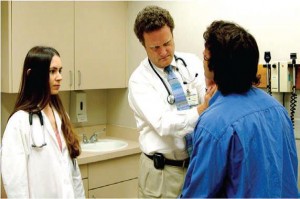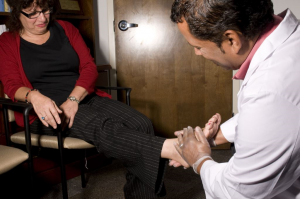Clinical | Quality & Safety
The Clinical Mission: Innovations in Patient Care | Quality and Patient Safety
- Rounding with Heart
- Artificial Pancreas Developed by UVA Offers Hope and Relief to Type 1 Diabetes Patients
- New Heart Valve Repair for High-Risk Patients: Scott Lim

Brian Wispelwey (Division of Infectious Diseases, Department of Medicine), with trainee and patient
The Department of Medicine and its more than 220 physicians are privileged to serve the people of the Charlottesville-Albemarle region, as well as thousands from elsewhere in Virginia and many other states. The department’s clinical care partners include University Medical Associates, University Physicians Charlottesville and University Physicians Orange. Over the last several years, with the opening of new facilities and clinics—including the Emily Couric Clinical Cancer Center (2011), Zion Crossroads Primary and Specialty Care Clinic (2013), and UVA Specialty Care Pinnacle Drive in Fishersville (2014)—the department has been able to significantly expand its geographical reach; the rapidly evolving area of telemedicine extends its reach even further, beyond geographical limitations. The recruitment of more than 40 new faculty members in 2014 will drive growth well into the future.
Expanding the Clinical Footprint
In FY 2014, UVA Health System completed arrangements for 100% ownership of Culpeper Regional Hospital. Alan Dalkin, vice chair of the Department of Medicine, comments: “The partnership established in 2009 between UVA and Culpeper Regional Hospital is now entering a new phase, and the Department of Medicine intends to work closely with the local caregivers to provide enhanced services and expand our footprint.” At UVA Specialty Care in Culpeper, a number of DOM divisions already offer services, including Allergy, Cardiology, Endocrinology, Gastroenterology, and Infectious Diseases.
Leading Change at UVA Health System
The provision of primary care and the practice of internal medicine are undergoing rapid change—and the Department of Medicine is on the frontlines. The reorganization of its primary care practices along the lines of the “primary care medical home” model, the change to the “firm” system for resident scheduling and training, and the transition of the entire medical center to an “accountable care organization” model, with key leadership from DOM faculty, are important examples.
Department of Medicine faculty are playing a leading role, as well, in the implementation of two new UVA Health System-wide programs, launched by Executive Vice President for Health Affairs Richard P. Shannon when he joined UVA in late 2013: the “Be Safe” campaign, and the “Rounding With Heart” initiative. Dr. Shannon, who has a faculty appointment in DOM’s Division of Cardiovascular Medicine and was previously chair of the Department of Medicine at University of Pennsylvania Health System, says the goal of “Be Safe” is no less than making UVA the safest hospital in America.
Be Safe “seeks to empower front-line healthcare workers and other team members—from the bedside nurse to environmental services personnel—to identify and call out safety and quality issues.” When safety issues arise, a real-time problem-solving process is triggered that includes leadership support and immediate access to institutional resources. DOM chair Mitch Rosner, along with DOM faculty member Susan Kirk, are serving on the senior leadership team for Be Safe; the program was piloted in Spring 2014 in the Pulmonary Division’s Medical Intensive Care Unit, as well as on the 5 Central unit. The focus of the pilot program was catheter-associated urinary tract infections (CAUTIs); the new process has yielded remarkable results, with a dramatic reduction in the number of CAUTIs.
Rounding with Heart, the focus of which is clinical excellence, addresses a host of care delivery issues by ensuring that caregivers from various disciplines who are treating a patient gather at the patient’s bedside daily, and include the patient and his/her family members in key decisions. It is being piloted in 4 East, the acute cardiac unit, during Fall 2014, with leadership from Division of Cardiovascular Medicine John Dent, MD.
Taking In-Patient Diabetes Care to the Next Level
The Inpatient Diabetes Management Program, organized and launched in FY 2014 by Endocrinology faculty members Jennifer Kirby and Tony McCall, is designed to improve the quality of diabetes care that inpatients at UVA Hospital receive, regardless of their primary diagnosis or unit in which they are being treated. The initial trial program focused on patients in the Thoracic Cardio-Vascular Post-Operative ICU, and the Endocrinology division plans to expand the program to other ICU locations over the next couple of years, and then eventually to all clinical units.
New Clinical Services
Along with the Diabetes Management Program, new clinics or services developed or established by DOM divisions during FY 2014 included:
- Fecal Microbiota Transplant Program
- Orthopedics co-management by the Hospitalist team (Fall 2014)
- Transplant Infectious Disease service
- Fully staffed 24/7 Hospitalist service
- Enhancement of multi-disciplinary oncology services
With leadership from George Hoke, head of the GMGPC’s Hospitalist section, and from Clint Merritt, who joined the team as its Medical Director in April 2014, the Hospitalist group has been instrumental in establishing UVA Health System’s new Transfer Center, which coordinates physician referrals and patient transfers. Hospitalists now field transfer requests for patients who will be placed in general medicine, gastroenterology, cardiology, hematology-oncology, and plastic surgery units; they also obtain clinical updates for general medicine patients who must wait more than 24 hours for transfer. These procedures ensure a more coordinated transition of care.
 Quality Improvement and Patient Safety
Quality Improvement and Patient Safety
Under the leadership of John Voss, Vice Chair for Quality and Patient Safety, the Department of Medicine has strengthened its quality improvement (QI) program over the last several years. DOM’s Institute for Quality and Patient Safety (IQPS) provides training and curriculum development in this area, and faculty liaisons for quality are designated for the larger divisions, with responsibility for overseeing division-specific quality projects.
In the last year, DOM’s quality and safety efforts have been focused on implementing the “Be Safe” initiative, discussed above, which was trialed in the Pulmonary division’s MICU unit in FY 2014. Additionally, George Hoke from General Medicine and Kyle Enfield from Pulmonary Medicine continue to work tirelessly – along with Stephanie Mallow-Corbett (Pharmacy), Rebecca McMullen (QPI), and Cheri Blevins (ICU Nursing) – to successfully reduce sepsis mortality, the leading cause of death among patients at UVA.
Some QI initiatives have resulted in significant cost savings for the institution: the Antibiotic Stewardship Program, led by Infectious Diseases’ Amy Mathers and Heather Cox, saved an estimated $4 million over the last four years; and the SCOPES project, headed by Gastroenterology’s Andy Wang and aimed at standardizing device utilization in the Endoscopy unit, produced almost $1 million in savings over its first two years.
A cornerstone of the department’s QI efforts is a 20-hour course, “Quality and Safety Leadership in Academic Medicine” (QSLAM), developed by Dr. Voss, Katharine Schlag and IQPS staff. First offered in 2010, the course has received high marks from over 200 participants, including chiefs, administrators and quality liaisons from the department’s divisions, as well as department-level administrators. It starts with an introduction to quality, safety and medical error, followed by sessions on systems thinking and human factors, root cause analysis, management of the QI process, and others. Attendees plan and implement a quality improvement project over a three- to six-month period, and present the results to the class.
IQPS offers the QSLAM course to staff throughout UVA Health System; graduates have included faculty, staff, fellows and graduate students from the departments of pathology and systems engineering, the School of Nursing and the Health System development office.
